Hello and welcome to a mathematical dungeon!!
Before we begin: You are in no way shape or form required to read this post. All concepts with equations are described in post "airfried"
This is the place for people especially interested in math and physics, specifically the part where you derive formulas. I will not go detailed through every step. However, we highly encourage you to read this post to better understand where different formulas come from and why we use them while planning to land on Lajaland.
As usual, "boring" posts will include a TLDR per section, memes and beauuuuutiful colors.
On our plan we have couple formulas we want to derive:
- Air resistance model, drag equation
- Terminal velocity
- Area of parachute
- Force of landing thrusters
Air resistance model, drag equation

NASA has given us this one already, hihi
\(F_d = \frac{1}{2}\rho C_d A v_{drag}^2 \tag{1}\)
Fd: Air resistance
A: Cross- section of landing unit (NOT THE ENTIRE SPACECRAFT)
\(\rho\): Atmosphere density (as a function of distance from planet surface)
Cd: Drag coefficient, which in general is not a constant. We assume this is 1.
Our job is to find vdrag which is the velocity of our spacecraft with respect to the atmosphere on Lajaland.
We define two variables first:
1. \(\vec{v}\), velocity of our spacecraft with respect to Lajaland
This is super easy to find. You do like this:
Karl: Computer, orient!
Computer: Your position relative to Lajaland is printed on the screen.
With a quick look at the screen we have our position! Tada!
2. \(\vec{w}\), angular velocity of the atmosphere on Lajaland as a function of the postion.
If you remember, the equation for angular velocity is \(\omega = \frac{2\pi}{T}\). No? Hmm you can read on it from our previous post. Angular velocity as a function of position? Oh yeah,
\(\omega = \frac{2\pi}{T}r \tag{2}\)
This makes vdrag = \(|\vec{v}-\vec{w}|\)
TLDR: Model for air resistance, the so-called drag equation: \(F_d = \frac{1}{2}\rho C_d A v_{drag}^2 = \frac{1}{2}\rho C_d A |\vec{v}-\vec{w}|^2\)

Terminal velocity

We reach terminal velocity when the maximum velocity has been reached and the object is no longer accelerating. This is when net force equal zero, the drag force equals gravity (Newton's first law of motion)
\(F_d = F_g\)
We have Fd, air resistance from (1), but with vterminal instead of vdrag.
Fg = mg from Newton's second law of motion, where g is gravitational acceleration on Lajaland and m is the mass of landing unit.
\(\frac{1}{2}\rho C_d A v_{terminal}^2 = mg \tag{3}\)
\(v_{terminal} = \sqrt{\frac{2mg}{\rho C_d A}} \tag{4}\)
(All the other variables are still the same)
TLDR: Terminal velocity, \(v_{terminal} = \sqrt{\frac{2mg}{\rho C_d A}} \)

Area of parachute

We got (3) saying \(v_{terminal} = \sqrt{\frac{2mg}{\rho C_d A}} \).
Instead of looking at terminal velocity, we shall be looking at something called safe velocity (which is 3 m/s). This is the maximum velocity required for a soft landing. Area of parachute is given as
\(A_{parachute}= \frac{2mg}{\rho C_d v_{safe}^2} \tag{4}\)
TLDF: You cannot be THIS lazy???? The answer is right above you.

Force of landing thrusters
I did not find any memes... sorry.
We are nearing the planet surface. In addition to a parachute, we are given a set of landing thrusters. From NASA, the force of landing thrusters is given as
\(F_L = F_g - F_d\)
Fg is given from (3)
Fd is given from (1) with respect to safe velocity, since we are getting ready to land and this is maximum velocity required for soft landing.
This gives us
\(F_L = \frac{1}{2}\rho_0A(v_{terminal}^2-v_{safe}^2)\)
\(\rho_0\): Atmosphere density on planet surface.
A: Cross-section of landing unit
TLDR: Force from landing thrusters \(F_L = \frac{1}{2}\rho_0A(v_{terminal}^2-v_{safe}^2)\)

